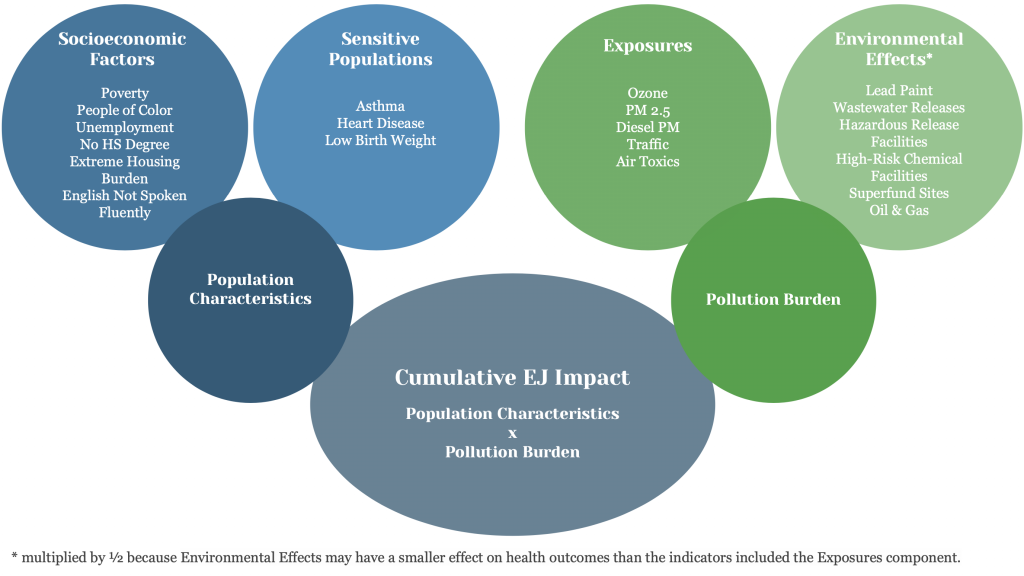how to read our map
To read more about our methods or access our data, please visit MEJ’s GitHub repository.
Cumulative EJ Impact
Cumulative EJ Impact combines measures of demographic vulnerability and exposure to pollution to create an overall score, allowing comparisons between areas within a state. This is expressed as a percentile.
To better understand what we mean by environmental impact, read more about our indicators and methodology below.
Percentile Rank
Every number you see on our map is a percentile. Each census tract in a state is ranked from lowest to highest, and the percentile expresses how it compares to other census tracts. For example, in Colorado, if a census tract has a Cumulative EJ Impact Score of 75, this means that this census tract ranks 937th highest out of all 1,249 census tracts, which makes its percentile score 75. This means that this census tract’s Cumulative EJ Impact is higher than 75% of all other census tracts in Colorado.
Indicators
MEJ’s map follows CalEnviroScreen’s methodology, combining Population Characteristics and Pollution Burden indicators to create an index of environmental injustice by census tract. A similar method has been used for maps in Washington, Illinois, and Michigan, among others. See the following links to learn more about these indicators:
Population Characteristics
Socioeconomic Factors indicators
Sensitive Populations Indicators
Pollution Burden
Exposures Indicators
Environmental Effects Indicators
Methodology
The negative effects of pollution depend on a combination of vulnerability and exposure. People living in poverty, for example, are more vulnerable to air pollution because they may lack access to quality healthcare. The method we use, following the method developed for CalEnviroScreen, reflects this in the two overall components of a census tract’s final Cumulative EJ Impact: Population Characteristics and Pollution Burden.
The CalEnviroScreen methodology was developed through an intensive, multi-year effort to develop a science-backed, peer- and community-reviewed tool to assess environmental justice in a holistic way. This methodology has since been replicated by several other states. Population Characteristics are a combination of socioeconomic factors (often referred to as social determinants of health) and indicators of sensitive populations, or health data, that together reflect a population’s vulnerability to pollutants. Pollution Burden is a combination of direct exposure and the presence of dangerous factors such as toxic waste sites or wastewater releases, which we call “environmental effects.” Together, Population Characteristics and Pollution Burden help describe the disproportionate impact that environmental pollution has on different communities.
Every indicator is ranked as a percentile from 0 to 100, indicating how a census tract compares to others. For example, if a census tract has an asthma score of 75, that means 75% of census tracts have lower asthma rates than the census tract at which you are looking. The indicators are then averaged with the others of the same component to form an overall score for that component. The Sensitive Populations component score, for example, is computed by averaging a census tract’s Asthma, Low Birthweight Infants, and Heart Disease indicators. T
he Sensitive Populations component ranking is calculated by taking the percentile rank of this score.
How Cumulative EJ Impact is calculated
- The Population Characteristics score is the average of the Sensitive Populations component score and the Socioeconomic Factors component score. The Population Characteristics percentile is the percentile rank of the Population Characteristics score.
- The Pollution Burden score is the average of the Exposures component score and one half of the Environmental Effects component score (Environmental Effects may have a smaller effect on health outcomes than the indicators included the Exposures component, thus they are weighted half as much as Exposures). The Pollution Burden percentile is the percentile rank of the Pollution Burden score.
- The Population Characteristics and Pollution Burden scores are then multiplied to find the final Cumulative EJ Impact score for a census tract. This final score is percentile-ranked to find a census tract’s final Cumulative EJ Impact ranking.
- Census tracts with no population aren’t given a Population Characteristics score.
- Census tracts with an indicator score of zero are assigned a percentile rank of zero. Percentile rank is then only calculated for those census tracts with a score above zero.
- Census tracts that are missing data for more than two indicators don’t receive a final Cumulative EJ Impact ranking.

